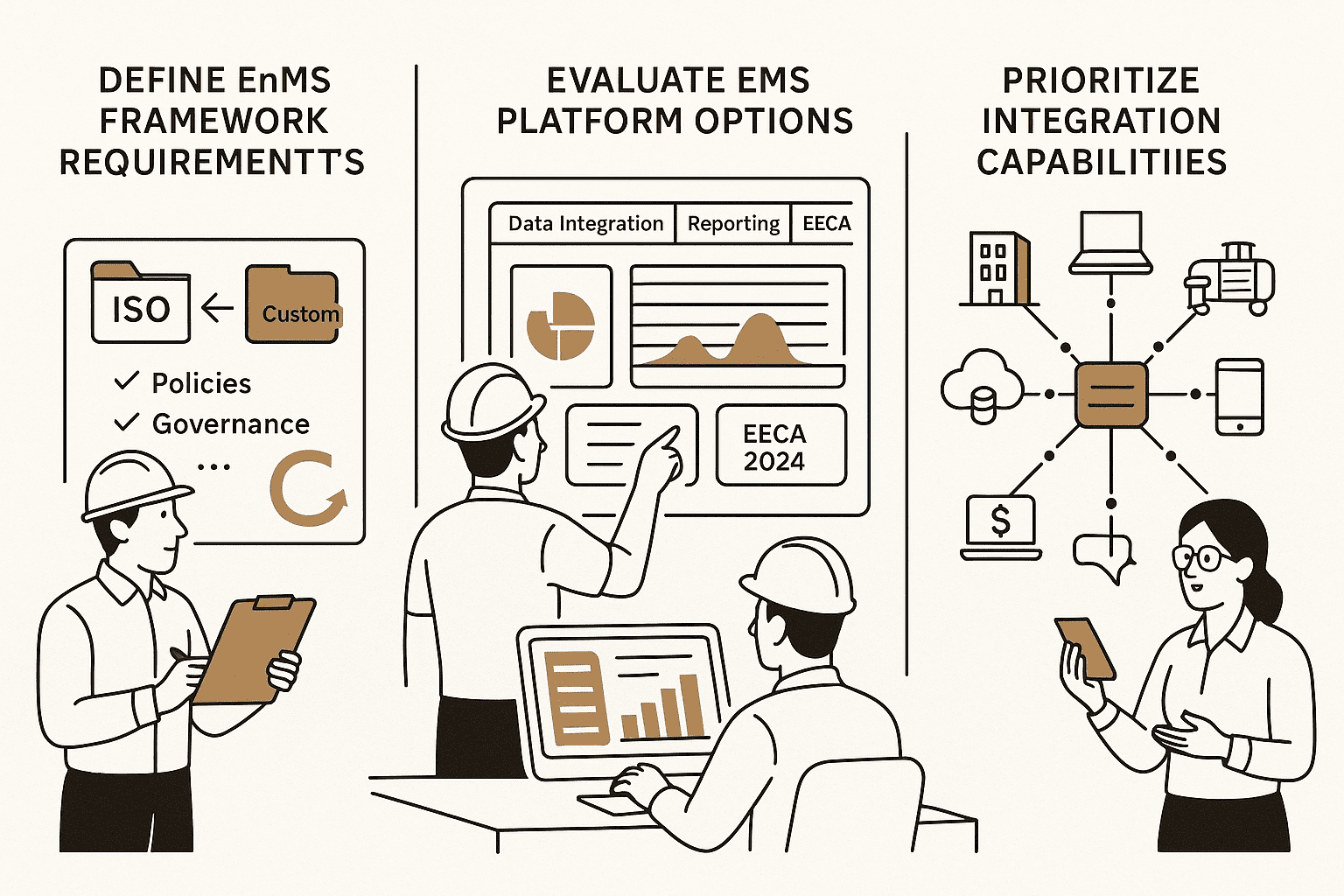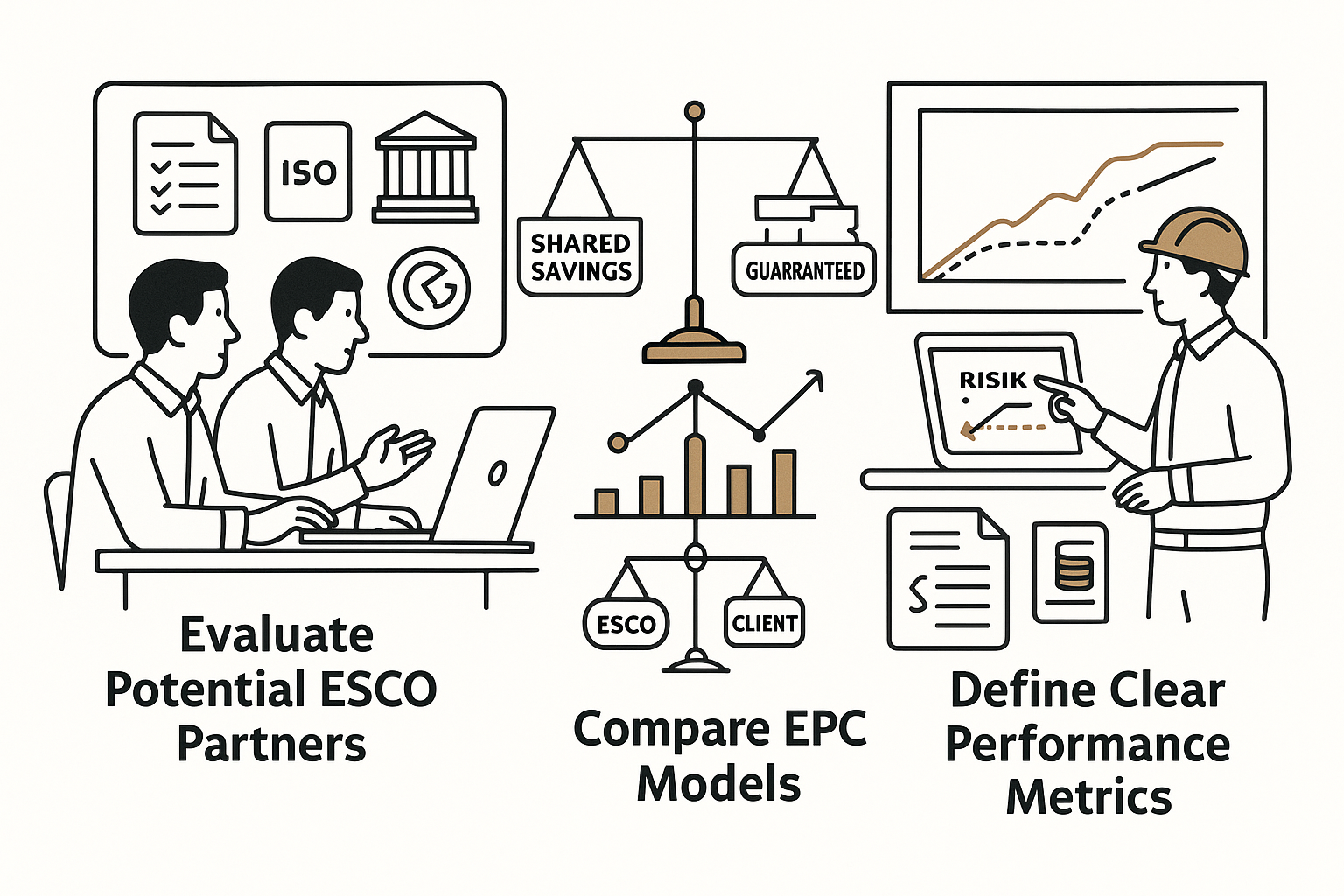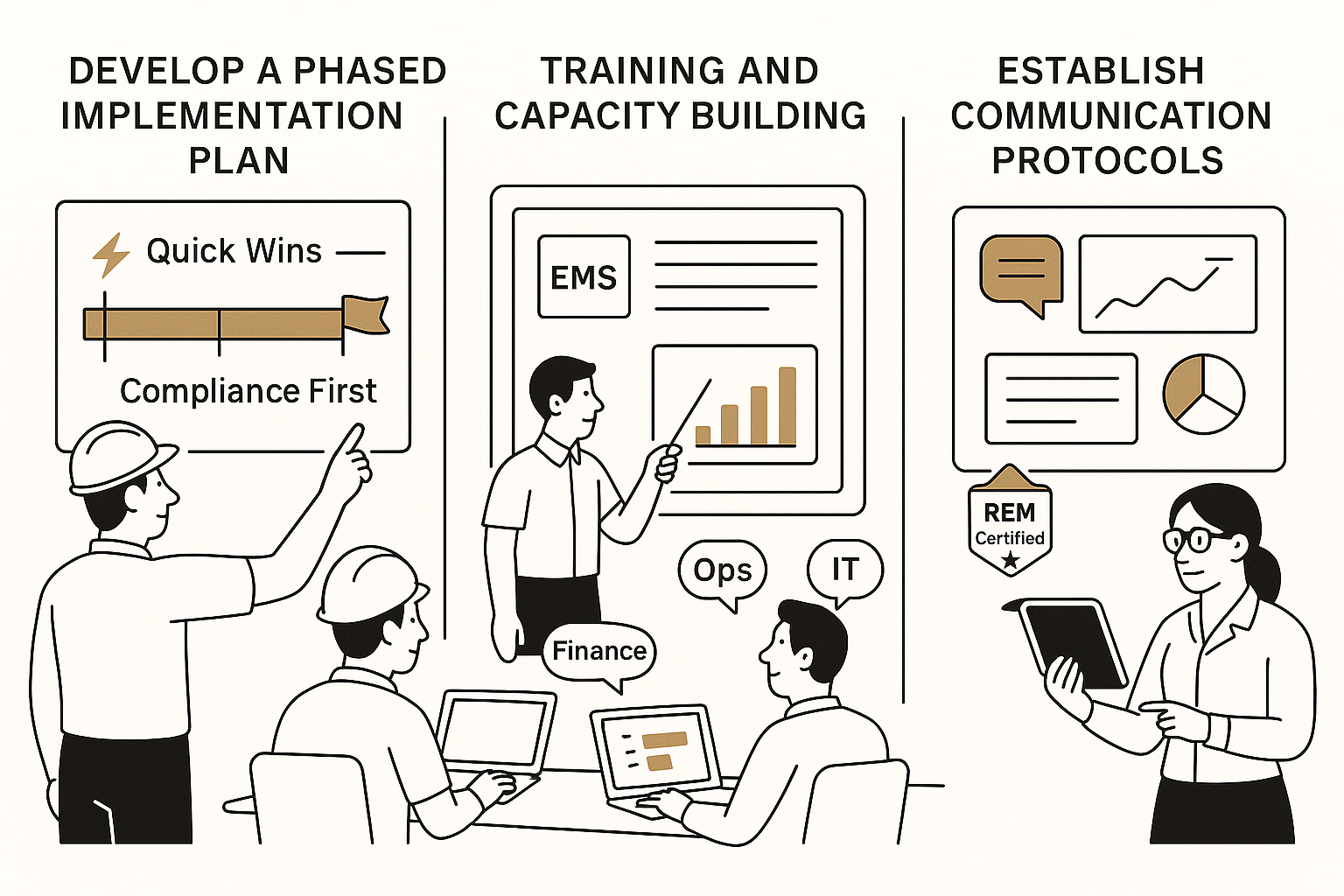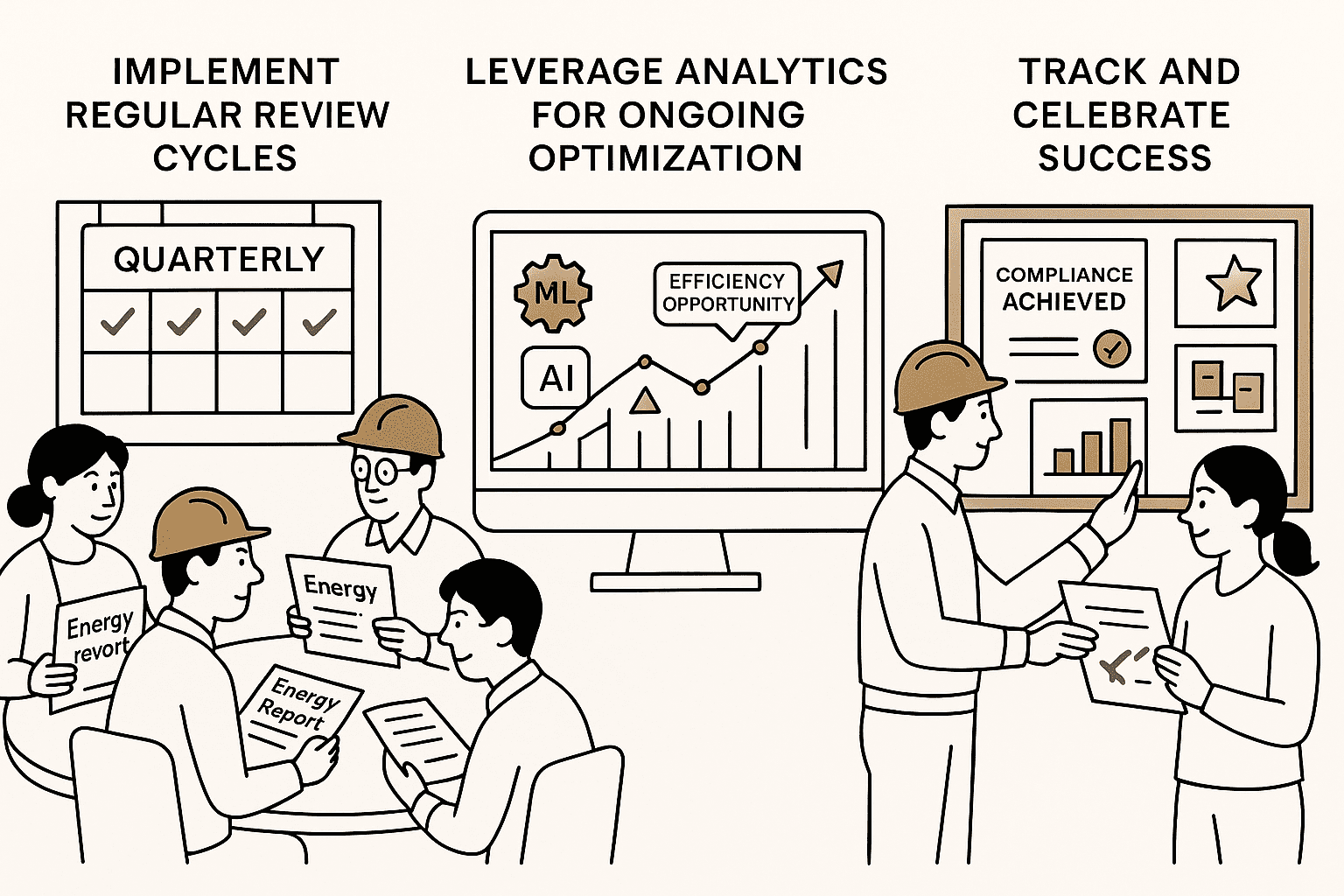Malaysia’s new Energy Efficiency and Conservation Act (EECA) 2024 represents a transformative shift in the nation’s approach to energy management and sustainability. This comprehensive legislation, which came into force on January 1, 2025, introduces mandatory requirements that will reshape how organizations across Peninsular Malaysia and Labuan approach energy efficiency. Success in this new regulatory landscape demands a unified approach across departments and strategic leveraging of Energy Management Systems (EnMS) and digital platforms to ensure compliance while maximizing business benefits.
Malaysia’s New Energy Efficiency Era
Malaysia’s journey toward energy efficiency has reached a critical milestone with the implementation of EECA 2024. This legislation represents the culmination of years of policy development, including the National Energy Efficiency Action Plan (NEEAP) 2016-2025, and aligns with Malaysia’s commitment to achieve carbon neutrality by 2050[1]. For the first time, energy efficiency is elevated from a purely technical concern to a strategic priority requiring organization-wide coordination.
The Act, which received royal assent on November 14, 2024, introduces comprehensive requirements for large energy consumers, specific buildings, and energy-using products[2]. Unlike previous initiatives that relied heavily on voluntary participation, EECA 2024 establishes mandatory compliance measures with significant penalties for non-adherence, ranging from RM20,000 to RM100,000[2].
📘 EECA 2024 Essentials
Want a quick overview of EECA 2024 compliance requirements? Learn about energy audits, reporting, penalties, and actionable steps for your business.
👉 Read More About EECA 2024 Compliance
This regulatory shift comes at a time when energy management has already become an executive imperative globally. As both a major operating cost and sustainability driver, companies must now aggressively tackle scope 1, 2, and 3 emissions across their entire enterprise, including production, logistics, R&D, and administrative functions[3]. In this context, cross-departmental collaboration is not just beneficial-it’s essential for compliance and competitive advantage.
"Innovast has extensive experience working with large energy consumers and commercial buildings to meet EECA 2024 requirements. From conducting energy audits to implementing energy management systems, our team ensures compliance while unlocking cost-saving opportunities."
Evolution of Energy Efficiency Policy in Malaysia
Malaysia’s approach to energy efficiency has evolved significantly over the past decade. In 2013, the government approved the implementation of the Energy Performance Contract (EPC) concept in the government sector, creating a foundation for energy efficiency improvements in public buildings[4]. This was followed by the National Energy Efficiency Action Plan 2016-2025, which established a broader framework for energy efficiency initiatives across sectors[5].
The Energy Transition Roadmap further strengthened this commitment, with the Minister of Energy, Green Technology, Science, Climate Change and Environment announcing initiatives like retrofitting 50 government buildings with energy-efficient lighting and appliances through Energy Performance Contracts (EPCs)[4]. These policy developments laid the groundwork for EECA 2024, which represents the most comprehensive and enforceable approach to energy efficiency in Malaysia’s history.
The Language Barrier: Why Departments Struggle to Align
One of the greatest challenges in achieving EECA 2024 compliance is the “language barrier” that exists between different departments within organizations. This communication gap often leads to misalignment, inefficiencies, and ultimately, compliance risks.
Department-Specific Perspectives
In most organizations, each department approaches energy management through its own distinct lens:
Engineering & Facilities Departments
Focus primarily on technical performance metrics, system optimization, and compliance with technical standards. Their language revolves around kilowatts, efficiency percentages, and system specifications. Energy efficiency initiatives are evaluated based on technical feasibility and operational impact.
Finance Departments
View energy primarily as a cost center. Their focus is on expense management, return on investment (ROI), payback periods, and budget allocation. Energy efficiency projects must compete with other capital investments for limited financial resources, and financial teams may lack the technical understanding to properly evaluate energy-saving opportunities.
Legal & Compliance Teams
Concentrate on regulatory requirements, risk management, and legal implications. With EECA 2024 introducing new mandatory requirements, legal departments must interpret complex technical regulations without necessarily having the engineering background to fully understand implementation challenges.
Operations Teams
Prioritize production targets, equipment reliability, and minimal disruption. Energy efficiency initiatives may be viewed as secondary concerns or potential risks to operational continuity.
Communication Challenges and Missed Opportunities
This departmental fragmentation creates significant barriers to effective energy management and EECA compliance:
When engineers propose energy efficiency improvements, they may struggle to translate technical benefits into financial terms that resonate with the finance department. A project with excellent energy-saving potential might be rejected because its financial case wasn’t presented effectively.
Similarly, finance teams may prioritize projects with faster payback periods over those with greater long-term energy efficiency benefits, failing to account for regulatory compliance risks or sustainability advantages that could provide strategic value.
Legal departments tasked with ensuring EECA compliance may issue directives without understanding the technical and financial implications, leading to inefficient implementation strategies or unnecessary expenses.
A Malaysian APEC Energy Working Group study highlighted this challenge, noting that improving “policy coordination among Ministries by providing a clear target on energy efficiency and emissions reductions” is essential for effective energy management at the national level[6]. This same principle applies within organizations, where coordination between departments is equally critical.
EECA 2024: What Every Department Needs to Know
The Energy Efficiency and Conservation Act 2024 introduces comprehensive requirements that impact multiple departments across organizations. Understanding these requirements from various departmental perspectives is essential for effective compliance.
Core Requirements of EECA 2024
The Act establishes three main categories subject to regulation[2][1]:
- Energy Consumers: Organizations consuming more than 21,600 gigajoules of energy over 12 consecutive months
- Large Office Buildings: Office spaces exceeding 8,000 square feet
- Energy-Using Products: Domestic appliances and other energy-consuming products

Large energy consumers
- Appointment of a Registered Energy Manager (REM)
- Implementation of an Energy Management System (EnMS), ideally aligned with ISO 50001
- Regular mandatory energy audits conducted by registered auditors
- Submission of annual energy efficiency reports detailing the management system, energy consumption, and proposed efficiency improvements

Large office buildings
- Displaying energy intensity labels prominently
- Meeting prescribed energy efficiency ratings
- Conducting energy audits and submitting improvement plans if buildings fail to meet efficiency standards

Manufacturers & importers of energy-using products
- Registration with the Energy Commission
- Obtaining Certificates of Energy Efficiency (COE) for products
- Compliance with Minimum Energy Performance Standards (MEPS)
Departmental Implications
Engineering / Facilities Depts.
- Technical responsibility for implementing and maintaining the EnMS
- Ensuring compliance with minimum energy performance standards for equipment
- Conducting or facilitating energy audits
- Developing and implementing energy efficiency improvement measures
- Technical oversight of Energy Performance Contracts (EPCs) if utilizing ESCOs
Finance Department
- Budgeting for required energy efficiency upgrades and EnMS implementation
- Evaluating financial implications of different compliance strategies (in-house vs. ESCO partnerships)
- Tracking and reporting energy cost savings
- Assessing the ROI of various energy efficiency initiatives
- Financial oversight of Energy Performance Contracts, including validation of savings claims
Legal / Compliance Depts.
- Interpreting EECA 2024 requirements and ensuring organizational compliance
- Managing registration processes with the Energy Commission
- Ensuring proper documentation and reporting to avoid penalties
- Overseeing contracts with ESCOs and other service providers
- Monitoring regulatory updates and evolving compliance requirements
Operations Teams
- Integrating energy efficiency considerations into operational processes
- Adapting to new equipment standards and operational procedures
- Balancing production requirements with energy efficiency goals
- Supporting energy audits and improvement initiatives
Cross-Departmental Implications
The interconnected nature of EECA 2024 requirements means that no single department can ensure compliance in isolation. For example:
- The appointment of a Registered Energy Manager requires coordination between HR, engineering, and legal departments
- Implementing an EnMS impacts processes across the organization and requires input from multiple stakeholders
- Annual reporting involves data collection and validation across departments
- Energy efficiency improvement plans must align with operational capabilities, financial resources, and compliance requirements
Organizations that approach EECA 2024 compliance as a siloed responsibility of the engineering or facilities department risk incomplete compliance, missed opportunities for cost savings, and potential penalties. A unified, cross-departmental approach is essential for both compliance and optimization.
EnMS and EMS Platforms: The Digital Bridge
At the heart of effective EECA 2024 compliance and cross-departmental alignment is the implementation of robust Energy Management Systems (EnMS) supported by digital Energy Management Software (EMS) platforms. These complementary solutions serve as the critical bridge between departments, translating energy data into actionable insights for each stakeholder.
Understanding EnMS and EMS
Energy Management System (EnMS) refers to the systematic framework an organization uses to manage energy use and improve efficiency. Often aligned with international standards like ISO 50001, an EnMS encompasses policies, processes, and practices for continuous energy performance improvement. EECA 2024 specifically requires large energy consumers to implement an EnMS[2].
Energy Management Software (EMS) platforms are the digital tools that enable real-time energy data collection, analysis, visualization, and reporting. These platforms transform raw energy data into actionable intelligence that can be customized for different departmental needs and requirements. While not explicitly mandated by EECA 2024, EMS platforms are practically essential for efficient EnMS implementation and cross-departmental alignment.
🛠️ Master EnMS Compliance Under EECA 2024
Dive deeper into the specifics of Energy Management Systems (EnMS) and how they align with EECA 2024 requirements. Learn practical steps for implementation, ISO 50001 alignment, and achieving energy efficiency goals.
👉 Read the Comprehensive Guide to EnMS Compliance
How EMS Platforms Bridge Departmental Gaps
Modern EMS platforms serve as the connective tissue between departments by providing:
Centralized Data Repository: All departments access the same accurate, real-time energy data, eliminating information silos and ensuring decisions are based on consistent information. This addresses a key challenge identified in energy efficiency implementation-the need for reliable data to inform decision-making[3].
Role-Based Dashboards and Reporting: Different stakeholders can access customized views of energy data tailored to their specific needs:
- Engineering sees technical performance metrics, system efficiency, and compliance status
- Finance views cost savings, ROI, payback periods, and budget impacts
- Legal monitors compliance status, reporting deadlines, and documentation completeness
- Operations tracks production efficiency and energy intensity metrics
Automated Compliance Reporting: EMS platforms can automate the generation of reports required by EECA 2024, ensuring consistency and reducing the administrative burden across departments. This includes energy consumption reports, audit documentation, and efficiency improvement tracking.
Common Language Translation: Advanced EMS platforms translate technical energy data into appropriate metrics for each department-kilowatt-hours for engineering, ringgit savings for finance, and compliance percentages for legal-facilitating cross-departmental understanding.
Collaborative Project Management: EMS platforms can track energy efficiency initiatives from proposal through implementation and verification, assigning tasks to appropriate departments and monitoring progress against both technical and financial targets.
Benefits for EECA 2024 Compliance
Implementing an integrated EnMS/EMS approach delivers specific benefits for EECA compliance:
Engineering / Facilities
- Streamlined monitoring of energy consumption across facilities
- Automated alerts for system inefficiencies or compliance issues
- Technical data to support energy audit requirements
- Evidence-based identification of efficiency improvement opportunities
Finance
- Transparent tracking of energy costs and savings
- Financial justification for efficiency investments
- Verification of savings from implemented measures
- Budget forecasting based on energy consumption trends
Legal / Compliance
- Automated generation of required compliance reports
- Documentation trails for regulatory submissions
- Early warning of potential compliance issues
- Evidence of due diligence in energy management
Executive Leadership
- Holistic view of organizational energy performance
- Strategic insights for long-term energy management
- Clear demonstration of compliance status
- Quantifiable ROI from energy efficiency initiatives
The National Energy Efficiency Collaboration (NEEC) established in 2023 by the Malaysian Green Technology and Climate Change Centre (MGTC) in partnership with industry leaders like ABB Malaysia, explicitly recognizes the importance of technology adoption in delivering energy savings and emissions reductions[7]. EMS platforms represent precisely the kind of technology that can drive tangible progress in energy efficiency adoption across sectors.
The Role of ESCOs: Driving Value with EMS
Energy Service Companies (ESCOs) play a pivotal role in Malaysia’s energy efficiency ecosystem, particularly in the context of EECA 2024 compliance. When empowered with EMS platforms, ESCOs can deliver enhanced value to organizations seeking both compliance and optimization.
ESCOs in the Malaysian Context
The Energy Performance Contract (EPC) concept was officially approved for Malaysia’s government sector in January 2013, establishing a market-based mechanism for energy efficiency improvements[4]. Under this model, ESCOs bear the initial cost for energy efficiency projects, with profits shared between the ESCO and the building owner based on achieved energy savings.
To participate in government EPC projects, ESCOs must register with both the Ministry of Finance (MoF) under the Green Technology Service Code (222801) and the Energy Commission[4]. This regulatory framework has helped accelerate the development of Malaysia’s energy service industry, increasing both the number of ESCOs and the investment in energy efficiency projects.
ESCO Business Models in Malaysia
ESCOs typically operate under several business models:
Shared Savings Model
The ESCO provides complete financing and implementation, eliminating your need for capital investment. Energy cost savings are split between you and the ESCO according to a pre-determined percentage over the contract period, offering a zero-risk approach to energy efficiency.
Guaranteed Savings Model
The ESCO guarantees specific energy savings and assumes all technical performance risk. You finance the project through a bank loan or your own capital, pay fixed fees to both the ESCO and lender, and keep 100% of the savings beyond these payments.
Energy Supply Contracting or Service Model
The ESCO finances and implements the entire project, then charges you only for the energy services delivered (e.g., per kWh or BTU). You pay for actual energy units consumed without worrying about equipment ownership or maintenance, while enjoying immediate utility cost reduction.
Leasing & Purchase (Rent-To-Own) Model
The ESCO finances and installs energy-efficient equipment, which you lease through regular payments over the contract term. At the end of the lease period, you have the option to purchase the equipment at a predetermined price, converting temporary savings into permanent assets.
💡 EPCs: The Key to Growth
Learn how Energy Performance Contracts (EPCs) and innovative financing can help your business achieve compliance and drive sustainable growth.
👉 Discover the Power of EPCs
How EMS Platforms Enhance ESCO Value Proposition
EMS platforms significantly strengthen the ESCO-client partnership by addressing key challenges in the energy service market:
Transparent Measurement & Verification (M&V):
One of the greatest challenges in energy performance contracting is verifying that energy savings result from implemented measures rather than other factors[4]. EMS platforms provide continuous, transparent measurement of energy consumption, establishing reliable baselines and accurately quantifying savings. This addresses a fundamental trust issue in the ESCO-client relationship.
Sophisticated Baseline Development and Adjustment:
Advanced EMS platforms facilitate the creation of detailed energy consumption baselines, accounting for variables like weather, occupancy, and production volumes through regression analysis. This ensures fair and accurate savings calculations, protecting both client and ESCO interests.
Real-Time Performance Monitoring:
Rather than waiting for quarterly or annual reports, EMS platforms allow both ESCOs and clients to monitor project performance in real-time, enabling rapid intervention if savings deviate from projections.
Departmental Value Demonstration:
EMS platforms translate energy savings into metrics meaningful to different departments-technical performance for engineering, financial returns for finance, and compliance status for legal-helping ESCOs demonstrate value to all stakeholders.
Enhanced ESCO Credibility:
By providing transparent, data-driven evidence of project performance, EMS platforms enhance ESCO credibility and facilitate trust-based long-term partnerships.
EMS-Enabled ESCO Services for EECA Compliance
ESCOs equipped with modern EMS platforms can provide specialized services for EECA 2024 compliance:
EnMS Implementation and Management:
ESCOs can design, implement, and manage EnMS frameworks that satisfy EECA requirements, utilizing EMS platforms to automate monitoring, reporting, and continuous improvement processes.
Registered Energy Manager Services:
ESCOs can provide qualified Registered Energy Managers as a service, leveraging EMS platforms to monitor multiple clients efficiently and ensure compliance with EECA requirements.
Compliance Reporting:
EMS platforms enable ESCOs to generate comprehensive compliance reports required by EECA 2024, including energy consumption data, efficiency improvements, and audit documentation.
Energy Efficiency Improvement Planning:
Using data analytics from EMS platforms, ESCOs can develop and implement targeted efficiency improvement plans that balance compliance requirements with financial constraints.
"Innovast offers a complete suite of services, including energy audits, EnMS implementation, and compliance reporting. Our InnoSense platform simplifies compliance by automating data collection, monitoring, and reporting, ensuring your business meets all regulatory requirements while optimizing energy use."
Case Example: Malaysian Manufacturing Facility
Consider a Malaysian manufacturing facility consuming over 30,000 gigajoules annually, making it subject to EECA 2024 requirements. The facility partners with an ESCO to implement an EnMS supported by an advanced EMS platform:
- The ESCO conducts an initial energy audit, establishing baseline consumption patterns.
- The EMS platform is implemented, integrating with existing building management systems and production equipment.
- Custom dashboards are created for each department: engineering sees technical performance, finance monitors cost savings, legal tracks compliance status, and operations observes production efficiency.
- The ESCO implements efficiency measures under a guaranteed savings model, with the EMS platform providing transparent verification of results.
- Automated reports satisfy EECA requirements for annual efficiency reporting, while also providing departmental insights for continuous improvement.
- The facility achieves full EECA compliance while reducing energy costs by 15%, with verified savings paying for the project within three years.
This approach aligns with recommendations from the APEC Energy Working Group, which emphasized the importance of “policy coordination among Ministries” and “clear target on energy efficiency”[6]. The EMS platform enables similar coordination at the organizational level, aligning departments around common energy efficiency goals.
Practical Steps for Implementation
Implementing a unified approach to EECA 2024 compliance through EnMS/EMS platforms requires careful planning and execution. The following step-by-step guide provides a roadmap for organizations at various stages of their compliance journey.
1. Assess Your Current Position

Conduct a Comprehensive Gap Analysis
- Evaluate current energy consumption against EECA 2024 thresholds to determine applicability
- Assess existing energy management practices against EnMS requirements
- Identify gaps in monitoring, reporting, and efficiency standards
- Review current staffing against the requirement for a Registered Energy Manager
Map Departmental Stakeholders & Requirements
- Identify key personnel in engineering, finance, legal, and operations who will be involved in compliance
- Document each department’s needs, concerns, and potential contributions
- Evaluate current cross-departmental communication mechanisms
Inventory Existing Systems & Data Sources
- Document current energy monitoring systems and data collection methods
- Identify integration requirements for a comprehensive EMS platform
- Assess data quality, completeness, and accessibility
🛠️ Getting Started with EECA 2024 EnMS
New to Energy Management Systems? Follow Raj’s journey as he navigates the first steps of EECA compliance, from forming an energy committee to creating an energy policy.
👉 Explore the Beginner’s Guide to EnMS
2. Develop a Strategic Compliance Plan

Define Clear Objectives Beyond Compliance
- Establish specific energy reduction targets aligned with business goals
- Identify financial objectives for energy cost reduction
- Set timelines for implementation and return on investment
Build Cross-Departmental Consensus
- Form an energy management committee with representatives from all key departments
- Develop a common understanding of EECA requirements and implications
- Establish shared KPIs that balance technical, financial, and compliance objectives
Evaluate Implementation Approaches
- Compare in-house implementation versus ESCO partnership
- Assess financial models (capital expenditure vs. operational expenditure)
- Consider phased implementation to prioritize high-impact areas
🎯 Master Energy Target Setting
Learn how to identify energy hogs, establish baselines, and set actionable goals to drive compliance and savings under EECA 2024.
👉 Read the Guide to Energy Assessment and Target Setting
3. Select Appropriate Technology Solutions

Define EnMS Framework Requirements
- Determine whether to align with ISO 50001 or develop a custom framework
- Document required policies, procedures, and governance structures
- Establish continuous improvement mechanisms
Evaluate EMS Platform Options
- Assess platforms based on data integration capabilities, analytics, and reporting features
- Ensure customizable dashboards for different departmental needs
- Verify compliance reporting capabilities specific to EECA 2024
- Consider scalability for future expansion and additional features
Prioritize Integration Capabilities
- Ensure compatibility with existing building management systems, production equipment, and IT infrastructure
- Evaluate integration with financial and compliance management systems
- Consider mobile accessibility for stakeholders across the organization
4. Consider ESCO Partnerships

Evaluate Potential ESCO Partners
- Verify ESCO registration with Ministry of Finance and Energy Commission
- Assess experience with EECA compliance and similar projects
- Review technical capabilities and financial stability
- Evaluate experience with EMS platform implementation
Compare EPC Models
- Assess shared savings versus guaranteed savings approaches
- Evaluate financial implications and risk allocation
- Consider impact on balance sheet and operational budgets
Define Clear Performance Metrics
- Establish transparent measurement and verification methodologies
- Define baseline adjustment protocols for changing conditions
- Document dispute resolution procedures for performance verification
5. Implementation and Change Management

Develop a Phased Implementation Plan
- Prioritize quick wins to demonstrate value and build momentum
- Address critical compliance requirements first
- Schedule implementation to minimize operational disruption
Invest in Training and Capacity Building
- Provide role-specific training for EMS platform users across departments
- Develop internal expertise for ongoing system management
- Consider certification for key personnel (e.g., Registered Energy Manager qualification)
Establish Communication Protocols
- Define regular reporting schedules and formats for different stakeholders
- Create escalation procedures for compliance issues or performance concerns
- Implement collaborative tools for cross-departmental energy management initiatives
6. Continuous Improvement and Optimization

Implement Regular Review Cycles
- Establish quarterly cross-departmental reviews of energy performance
- Conduct annual assessments of compliance status and risk
- Perform periodic evaluation of EMS platform effectiveness
Leverage Analytics for Ongoing Optimization
- Use EMS analytics to identify new efficiency opportunities
- Implement machine learning for predictive maintenance and optimization
- Refine energy management strategies based on performance data
Track & Celebrate Success
- Document compliance achievements and energy savings
- Recognize departmental contributions to energy management goals
- Share success stories internally and externally to build momentum
By following this structured approach, organizations can transform EECA 2024 compliance from a regulatory burden into a strategic advantage, driving both energy efficiency and cross-departmental collaboration.
Elevating Energy Management: Board-Level Reporting and Multi-Asset Integration
The strategic importance of energy management extends beyond departmental coordination to the highest levels of organizational governance. Modern EMS platforms provide powerful capabilities for board-level reporting and multi-asset portfolio management, particularly valuable for Real Estate Investment Trusts (REITs) and companies with diverse property holdings.
Transforming Energy Data into Executive Insights
For board members and C-suite executives, detailed technical energy data holds limited value. EMS platforms can transform this data into strategic insights that inform executive decision-making:

Strategic Performance Dashboards
- High-level visualizations of energy performance across the organization
- Progress against sustainability goals and EECA compliance requirements
- Benchmarking against industry peers and best practices
- Financial implications of energy efficiency initiatives
Risk and Opportunity Mapping
- Visualization of compliance risks across the organization
- Identification of high-potential areas for efficiency improvement
- Projection of energy cost trends and mitigation strategies
- Competitive positioning in terms of energy efficiency and sustainability

ESG Reporting Integration
- Automated data collection for environmental reporting
- Progress tracking for carbon reduction commitments
- Evidence for sustainability-focused investors and stakeholders
- Alignment with international reporting frameworks like GRI or TCFD
Multi-Asset Management for REITs and Portfolio Owners
For REITs and organizations managing diverse property portfolios, EMS platforms offer specialized capabilities to unify energy management across different asset types:

Portfolio-Wide Visibility
- Consolidated view of energy performance across industrial, commercial, and retail properties
- Normalization of data to enable fair comparisons between different building types
- Identification of underperforming assets requiring intervention
- Prioritization of investments based on efficiency potential and compliance requirements
Asset-Specific Optimization
- Tailored energy management strategies for different property types
- Customized efficiency targets based on building characteristics and use patterns
- Specific compliance monitoring for assets subject to EECA requirements
- Tenant engagement features for multi-occupant properties

Investment Decision Support
- Energy efficiency assessment for acquisition targets
- Retrofit ROI calculations for existing properties
- Energy cost projections for financial planning
- Valuation impact analysis of efficiency improvements
Governance and Accountability
EMS platforms strengthen governance structures by enhancing transparency and accountability:

Clear Responsibility Assignment
- Mapping of energy management responsibilities across the organization
- Tracking of key performance indicators at individual, departmental, and divisional levels
- Documentation of actions taken to address efficiency opportunities or compliance issues
Audit Trails and Verification
- Comprehensive records of energy data for external verification
- Evidence of due diligence for regulatory compliance
- Documentation of methodologies for savings calculations
- Transparent tracking of efficiency investments and returns
Board-Level Compliance Assurance
- Regular reporting on EECA compliance status across the organization
- Early warning of potential compliance issues requiring intervention
- Documentation of compliance efforts for regulatory authorities
- Strategic alignment of compliance activities with broader business objectives
By leveraging these capabilities, organizations can elevate energy management from an operational concern to a strategic priority, enabling board-level oversight and portfolio-wide optimization in the era of EECA 2024.
Conclusion: Unifying for Success in Malaysia’s Energy Efficient Future
The implementation of the Energy Efficiency and Conservation Act 2024 marks a decisive shift in Malaysia’s approach to energy management, establishing mandatory requirements that demand a coordinated, organization-wide response. Success in this new regulatory landscape requires breaking down traditional departmental silos and implementing integrated solutions that translate energy data into meaningful insights for all stakeholders.
Energy Management Systems (EnMS) and Energy Management Software (EMS) platforms serve as the critical bridge between departments, enabling engineering, finance, legal, and operations teams to collaborate effectively toward common goals. When enhanced through partnerships with experienced Energy Service Companies (ESCOs), these platforms can transform EECA compliance from a regulatory burden into a strategic advantage.
The organizations that will thrive in Malaysia’s energy-efficient future will be those that recognize energy management as a cross-functional imperative rather than a departmental responsibility. By unifying departments through shared data, customized insights, and collaborative tools, they will not only achieve compliance but unlock significant value through reduced costs, improved operations, and enhanced sustainability.
As Malaysia continues its journey toward carbon neutrality by 2050, the systems and partnerships established today will lay the foundation for ongoing innovation and optimization. The ultimate beneficiaries will be not only the organizations that embrace this unified approach but the nation as a whole, as it builds a more sustainable, energy-efficient economy for future generations.
Innovast: Empowering Energy Efficiency and Sustainability
At Innovast, we specialize in transforming energy management challenges into opportunities for growth and sustainability. As a leading energy solutions provider in Malaysia, we offer cutting-edge technologies, including IoT-driven energy monitoring, AI-powered analytics, and cloud-based energy management systems. Our expertise in EECA 2024 compliance ensures that businesses not only meet regulatory requirements but also unlock significant cost savings and operational efficiencies.
With a commitment to driving sustainability, Innovast partners with organizations to achieve their energy goals while contributing to Malaysia’s carbon neutrality targets. Whether you’re navigating the complexities of energy audits, implementing an EnMS, or exploring renewable energy integration, Innovast is your trusted partner for a smarter, greener future.
Contact us today to learn how we can help your business thrive in the era of energy efficiency. Visit Innovast or call us at +60 12 355 6214.
- https://www.tuv.com/regulations-and-standards/en/malaysia-new-energy-efficiency-and-conservation-act-eeca-2024.html
- https://dnh.com.my/introduction-of-the-energy-efficiency-and-conservation-act/
- https://www.slideshare.net/slideshow/toward-energy-management-40-delivering-an-enterprisewide-energy-management-system/240898285
- https://www.rdslawpartners.com/post/the-energy-efficiency-and-conservation-act-2024-transforming-malaysia-s-energy-landscape
- https://policy.asiapacificenergy.org/node/1269
- https://www.apec.org/docs/default-source/publications/2019/3/follow-up-peer-review-on-energy-efficiency-in-malaysia/ewg_follow-up-peer-review-on-energy-efficiency-in-malaysia.pdf
- https://new.abb.com/news/detail/120189/abb-collaborates-with-industry-partners-to-host-flagship-energy-efficiency-conference-in-malaysia












1 thought on “The Ultimate Guide to EECA 2024 Compliance: Uniting Departments and Empowering ESCOs with EnMS and EMS Platforms in Malaysia”
Pingback: EECA 2024: Energy Standards for Malaysian Commercial Buildings